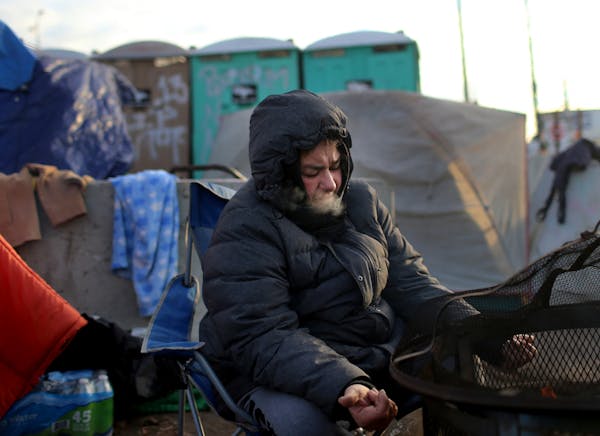The thousands of people who drove past the large homeless camp along Hiawatha Avenue this summer got a firsthand look at a critical problem in Hennepin County.
The camp's population was predominantly American Indian. That mirrored the county's homeless numbers in which 70 percent are people of color.
The camp, also known at the Wall of Forgotten Natives, galvanized Indian community leaders and social service groups to take action. It also became an opportunity for county and Minneapolis officials to start an initiative to address racial disparities among people experiencing homelessness.
On Tuesday, more than 200 policymakers and people who work with the homeless gathered at Sabathani Community Center in Minneapolis for the county's annual "Heading Home Hennepin" meeting. Minneapolis will be the eighth city to join the Center for Social Innovation's national study on the causes of racial inequalities for the homeless and solutions for change, it was announced.
"We no longer want just empty rhetoric," Minneapolis Mayor Jacob Frey said. "Housing is a right. And the lack of affordable housing is an epidemic."
The mayor has put his money where his mouth is by budgeting a record $40 million for affordable housing throughout the city, not just certain neighborhoods. The primary driving force behind racial disparity and the homeless was a systematic plan to segregate specific minority and religious groups from other communities and housing discrimination, Frey said.
The mayor noted that 65 percent of the homeless in Hennepin County are black and that one out of 10 school-age students has had some experience with homelessness. He said he was surprised when he toured several homeless shelters several years ago and learned that a large number of the occupants had jobs.
"I believe it was good for people to see the camp on Hiawatha, but it doesn't mean homelessness is happening for the first time," he said. "People need to come to terms with it and start to tackle this inequality."
The county has already taken some steps to address the issue. In partnership with the Center for Social Innovation, the county is offering a four-day training session on disparities and the homeless for front-line workers. More than 200 people signed up for it.
The county also hired Alex Tittle as its disparity reduction director six months ago. Minnesota has long been known as a state with one of the largest racial disparity gaps in the United States, he said. The median income for a black family is $30,000 and $66,000 for a white family, he said. By 2050, people of color will be the majority population in the county, he said.
"We are doing horribly," Tittle said. "It's going to take a unique solution."
Besides several speakers, the two-hour meeting featured a presentation from the Mill City Players, a group of teens who have dealt with homelessness. It was the first time they performed in public, and they received a standing ovation.
Jeff Olivet from the Center for Social Innovation spoke briefly about the group's initial study results, which were completed in March. The participants included Atlanta, Columbus, Ohio, Dallas, San Francisco, Syracuse, N.Y., and Pierce County, Wash.
The conclusions were nearly identical in all the areas: blacks and Indians became homeless at a significantly higher rate than their actual population numbers, he said. The majority of the homeless were between the ages of 18 and 24.
"Racism and homelessness don't often get spoken in the same sentence," Olivet said. "Homelessness is the result of structured racism in this country. It's more than just poverty or bad decisions."
That racism included white people taking the land of Indians and the genocide of their people, slavery and mass incarceration, he said.
"Homelessness is not inevitable," he said. "We can undo the system."
Robert Lilligren admitted he never really had contact with homelessness until he and other Indian leaders became concerned about the growing camp on Hiawatha in August. He is president of the Native American Community Development Institute, and the camp was only a few blocks from his office.
Frey reached out to him and other leaders who were able to work quickly to start to solve the problem. They set up a hygiene center, hired four people to provide meals and services and provided a doctor to check on the most critically ill people in the camp.
"This formerly invisible group now became visible," Lilligren said. "I am concerned that once the camp is gone, the sense of urgency for the community to address disparity and homelessness will become less important."
For his part, the Bush Foundation gave his institute a grant to help the homeless work through their traumas and figure out why so many camp dwellers who got housing often went back to the camp.
"How do we break down those barriers?" he asked.
David Chanen • 612-673-4465
Carolyn Parnell, 'trailblazer' who served as Minnesota's first IT commissioner, dies


